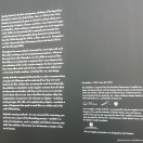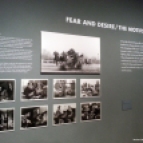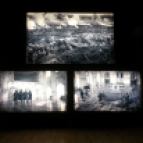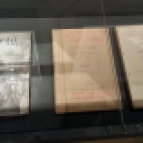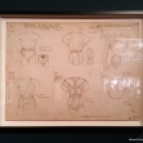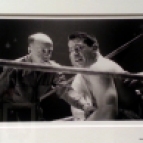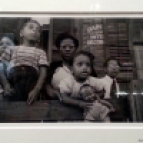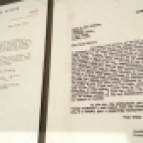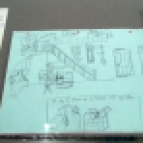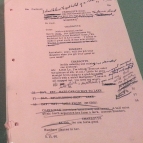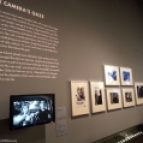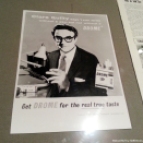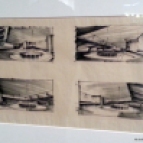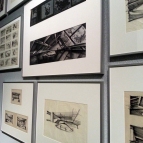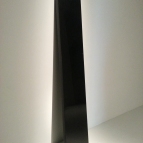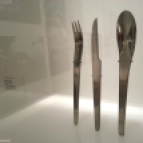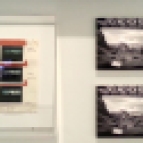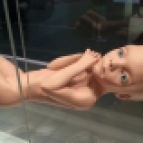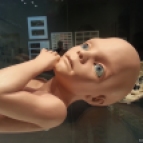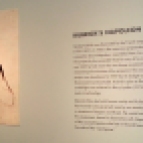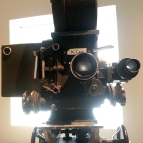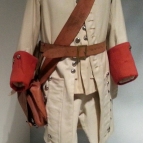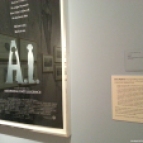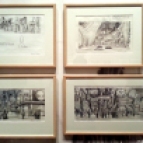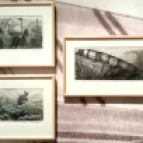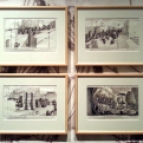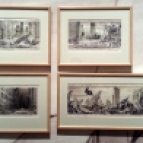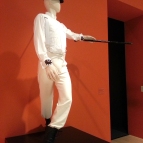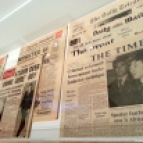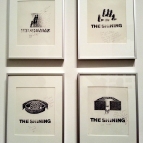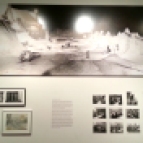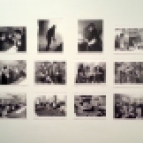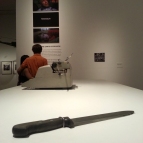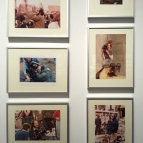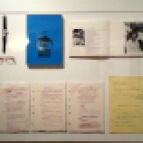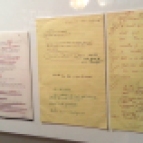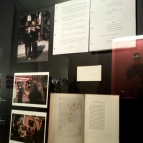Explosions in the Sky – Your Hand in Mine. San Francisco, 1906 [Skiffleboom.com]

By Michael McVey, Skiffleboom.com
Market Street, San Francisco. Filmed just four days before the Great Earthquake leveled the city in 1906. Music by Explosions in the Sky - Your Hand in Mine Michael McVey Skiffleboom.com
“The Birth of a Nation” – Racism in Early American Film, from Skiffleboom.com
Michael McVey
History of the Moving Image- VMA 115
Bunker Hill Community College, Charlestown, MA
The Birth of a Nation Response – February 25, 2010
The Birth of a Nation:
Describe a scene you find disturbing. What specifically makes it disturbing? Think in terms not only of the characters, but also of the specific shot sequence and the relationship the image creates.
Election Day and Results Sequence: 1:48 – 1:53
The election sequence from “The Birth of a Nation” is an incendiary account of shifting social and political power during Southern Reconstruction. The sequence narrowly characterizes class and race relationships with broad stereotypes. Griffith portrays historical events with one-dimensional characters. These characters disturbingly polarize the conflict’s complexities into simple good and evil. We begin with the title card:
“Election day. All blacks are given the ballot, while the leading whites are disfranchised.”
Both black and white voters line up to vote. A white man, presumably a carpetbagger, takes ballots from black voters. Black soldiers flank the man, keeping the crowd orderly. When white voters attempt to vote, they are denied. Soldiers aggressively shove these men out of line with their rifles. We cut to Dr. Cameron and his son Ben leaving their Piedmont home to vote. We cut to black and fade in on Dr. Cameron attempting to vote. He is denied and aggressively ejected. From this short scene, we infer that all Southern white voters were denied their rights from Unionists and Carpetbaggers, backed with military muscle. The use of these broad, unnamed characters and actions nurture resentment in the viewer towards the blacks. The use of these broad stereotypes is propaganda, influencing the audience to feel that blacks with power are unjust and malevolent.
“Receiving the returns. The negroes and carpetbaggers sweep the state.”
We cut to the interior of Silas Lynch’s Piedmont headquarters. Lynch is the mulatto protégé of Reconstruction authority Austin Stoneman. Lynch’s mixed-race staff rushes election results into the office. The title card declares, “Silas Lynch is elected Lieut. Governor.” Stoneman is elated when Lynch presents him with the news, and Stoneman’s daughter Elsie joins them. She is fancily dressed.
The title card reads, “Celebrating their victory in the polls.” We cut to an exterior shot of an all-black Unionist army marching through Piedmont, joyously greeted by an all-black crowd. We cut back to the interior of Lynch’s headquarters. While Austin Stoneman speaks of the election, we cut to a medium close-up of Lynch staring lustfully. We cut to a medium shot of Elsie as she sorts white paperwork. We cut back to Lynch. He covers his genitals with a black hat as he stares. We cut once more to Elsie. It is clear that the newly elected Lynch has designs on Stoneman’s daughter. Stoneman seems oblivious to this aside.
Lynch walks outside, and is immediately embraced by the all-black crowd. He is hoisted onto their shoulders and paraded about. We cut to Stoneman observing from inside, pleased with the victory. We then cut to Elsie, who stands alone in the room, looking exposed. We infer from this scene that the newly elected Lynch is a devious character. Lynch’s leering is juxtaposed against a marching army of black soldiers, eliciting fear of a black takeover of traditionally white properties. For Stoneman, the mulatto character of Lynch represents a bridge for race relations, but Griffith suggests his (and possibly all mulattos) motivations are animalistic and devious. In the wake of Lynch’s sexual intonations, Elsie’s delicacy is amplified through the lingering shot.
“’The little Colonel’ relates a series of outrages that have occurred.”
Ben Cameron sits in his home with his father and friends. A candle burns in the foreground, representing the smoldering hatred of the White southerner during Reconstruction.
The title card reads “The case was tried before a negro magistrate and the verdict rendered against the whites by the negro jury.” A crowded courtroom scene establishes the shift in power. An all-black jury and a black magistrate free a black man accused of a crime – the white victim’s family looks despondent. The camera iris focuses on the magistrate, yelling fervently. The ‘not guilty’ verdict polarizes the courtroom. The whites and the ‘faithful’ blacks are outraged by the verdict. The black defendant shakes hands with the jury. The scene exudes collusion and injustice.
We cut back to the Ben Cameron relating the story. We cut to the exterior of the courthouse, where black soldiers treat the white victim’s family with hostility. We cut to a shot of soldiers brutalizing an old man. These black soldiers are clearly villainous.
The title card reads, “Even while he talks, their own faithful family servant is punished for not voting with the Union League and Carpetbaggers.” The “faithful” family servant’s only discernable characteristic is his steadfast loyalty to the Cameron’s. Having voted against the Unionists, two deceitfully friendly blacks lure the servant to the woods. Several black soldiers ambush the servant. The soldiers bind him to a tree and lash him for his faithfulness. We fade out.
We cut to the servant’s quarters, where an elderly black man searches for his friend. When the elderly man stumbles upon the black soldiers beating the servant, he intervenes. A soldier murders the old man in cold blood. The soldiers all run away in cowardice. We cut back to Ben Cameron relating his stories. We see clearly from these cuts that Griffith is employing parallel editing. The iris closes in on Cameron, who dramatically stands, as though he has reached his breaking point. The camera cuts to the servant, beaten and bewildered, he runs from frame. We cut back to the Cameron’s. The stories deeply move the group, and they stand together, unified by their disgust.
The title card reads, “The faithful soul enlists Dr. Cameron’s sympathy.” We cut to Dr. Cameron, Ben’s father finding the servant in the woods. We cut back to the Cameron home. The servant relays the events to Ben Cameron, who looks furious. The candles blaze in the foreground.
These scenes shockingly suggest that blacks are incapable of dispensing justice properly. The black magistrate, while only briefly portrayed, comes across as a zealot. All the black Union soldiers are portrayed as cowardly, vicious torturers. We infer that blacks are duplicitous from the way the servant was lured into an ambush. Though Griffith doesn’t cast the servant under the same evil light as the other blacks, his is still one-dimensional. His defining characteristic seems to be an acceptance of his place in the old Southern hierarchy.
Perhaps the most disturbing element of this sequence is the technical craftsmanship. The innovative use of symbols to create subtext makes the film potent propaganda. Carefully staged scenes, clever set and costume design, and innovative editing techniques made the film’s simplistic views entertaining and digestible. “The Birth of a Nation” was a new form of entertainment propaganda in 1915. This is exceptionally disturbing, considering that these are not the film’s most cartoonish and unbelievably racist stereotypes. That award goes to the scene that caps the election sequences:
“The riot in the Master’s Hall. The negro party in control in the State House of Representatives, 101 blacks against 23 whites, session of 1871. An Historical Facsimile of the State House of Representatives of South Carolina as is was in 1870. After photograph by ‘The Columbia State.’”
Documentary Film and Fictional Technique from Michael McVey, Skiffleboom.com
Michael McVey
April 22, 2010 – Bunker Hill Community College
VMA 115 – History of the Moving Image – Professor Pastel
Writing Assignment #3 – Documentary
In a 2-3-page paper, address the following questions:
Use several specific examples from two of the following films to answer the questions below: Nanook of the North, Triumph of the Will, The Plow That Broke the Plains, Salesman, Don’t Look Back, High School, Our Daily Bread, Roger and Me:
1. Explain how a documentary film can use fictional techniques, yet claim to represent ‘reality.’
2. Identify some of those fictional techniques, using specific sequences from the film(s). That is, describe a particular sequence from a movie and explain how it uses fictional techniques to make its point.
3. Explain how a documentary film is different from a fictional narrative – i.e., why should we trust what that what it shows is “true” to reality as opposed to being merely “made up?”

The Lumière brothers’ earliest footage was captured on location using real people. This early film, "La Place des Cordeliers à Lyon," captured an unstaged street scene, and can be considered one of the earliest documentaries.
The documentary form has existed since the birth of the motion picture camera. The Lumière brothers’ early footage was captured on location using real people. Their early film La Place des Cordeliers à Lyon captured an unstaged street scene, and can be considered one of the first documentaries. Over the past century, attempts to document reality have changed radically. Advances in technology and technique have resulted in a variety of documentary styles, calling into question the definition of the word “documentary.”
Documentary films often employ fictional techniques. Manipulative editing, staged shots, manipulated audio, scripted narration, overlaid graphics and music – many of these techniques can be found in documentaries. How can fictional techniques be used in a documentary engaged with reality and truth?
Capturing reality is the conceit of documentary film. Since reality can never be truly replicated by film (or any medium), the term documentary can apply to approximations of reality. Both fictional and documentary films employ “lies” in order to tell “truth.” Raw footage and audio is edited into a watchable length, with emphasis on dramatic structure. Since people edit the footage, the editing choices have authors and points of view. So if a documentary cannot be reality, it certainly can represent reality. It can be representative of the filmmakers’ perspective.
Our Daily Bread presents reality with a distinct perspective. Shots of workers eating lunch punctuate a sequence of pigs being slaughtered, gutted, and cleaned. The filmmakers carefully chose this juxtaposition as a dramatic device. The viewer is given the imagery to contemplate. While the presentation of the imagery is crafted, the imagery itself captures actual events.

Nanook of the North - The filmmaker’s intended to accurately portray a vanishing lifestyle. But unwieldy technology and a hostile environment forced planning and staging.
Nanook of the North contains many staged events. Robert J. Flaherty accentuated the Inuit lifestyle’s romance and danger and presented in it as documentary. Staged events are a staple of narrative film. It was reported that Nanook was not the subject’s real name. Nyla was not Nanook’s real wife. Events were photographed with direction from Flaherty: Nanook was instructed to use traditional Intuit hunting weapons, as opposed to guns. His igloo was clearly constructed to accommodate film equipment. The filmmaker’s intended to accurately portray a vanishing lifestyle. But unwieldy technology and a hostile environment forced planning and staging. Many critics feel these staged scenes, presented as truth, disqualify the film from true documentary status.
Michael Moore’s Roger and Me unapologetically borrows many fictional techniques. Scripted voice over, the juxtaposition of soundtrack music over imagery, the inclusion of overlapping audio – these are just a few elements Moore borrows from narrative film. Yet the film is curiously considered a documentary over Nanook of the North. This can be attributed to the inclusion of Moore within his own film. Moore is very much a part of the story. Because of this, scenes that may otherwise appear staged are not; the stager is a part of the scene he is staging. Nanook’s Flaherty and the filmmakers hid their presence. As a result, their footage can be considered misleading.

Roger and Me - During the climactic speech by Roger Smith, the film cuts between footage of Sheriff Fred Ross evicting a family on Christmas Eve. Used to illustrate hypocrisy, this ironic intercutting leads the viewer to believe these events happen simultaneously.
Roger and Me follows a three-act structure, which is commonly found in fictional narrative. During the climactic speech by Roger Smith, the film cuts between footage of Sheriff Fred Ross evicting a family on Christmas Eve. Used to illustrate hypocrisy, this ironic intercutting leads the viewer to believe these events happen simultaneously. Narrative film often stitches together shots taken at two different times. In The Lord of the Rings: Return of the King, Sam and Frodo rest on their journey to Mordor. This scene contains a two-shot of the characters talking. The shots were taken two years apart from each other, but are edited together seamlessly. Both documentary and narrative film can structure time and continuity, regardless of reality.
The Maysles Brothers’ Salesman is a documentary in the style of direct cinema. The film contains no omniscient narrator, but contains a scene in which Paul’s monologue is used as narration. Paul drives through Miami, talking about his fellow salesmen, while the scene cuts to each of the men he describes. This editing clarifies and describes each of these men from Paul’s point of view. This technique borrows from fictional narrative while sustaining its “truth,” or exclusive use of shot footage.
Earlier documentaries, such as The Plow That Broke the Plains, use narrators to tell their stories. Narrated documentaries can be accepted as “true,” as they deal with facts and true events. But such films contain staged footage, and while their content may be taken from actuality, the film itself is not true. It is illusion that deals in truth.

The Maysles Brothers’ "Salesman" is a documentary in the style of direct cinema. The film contains no omniscient narrator, but contains a scene in which Paul’s monologue is used as narration. Paul drives through Miami, talking about his fellow salesmen, while the scene cuts to each of the men he describes.
Salesman contains a flashback device: Paul sits on a train, heading back from a sales conference. The film overlaps audio, cutting to the actual sales event. This flashback is fictional narrative a device. It also reveals the filmmaker’s intention to present reality subjectively. There is no way to know what Paul was thinking about during that moment. But the filmmakers suggest he thought about his conference. They use images of Paul to smoothly transition through time. The filmmakers suggest that Paul probably thought back on the conference during his trip home. Since the assertion seems likely, the many viewers may accept this editing manipulation. Some viewers adhere to strict definitions, such as cinéma vérité purists, and do not consider this technique valid when portraying “reality.”
In Salesman, the Maysles Brothers goal is to represent reality truthfully. The film is shot as objectively as possible. The brothers acknowledge that the camera’s presence affects behavior, but they keep interference to a minimum, photographing subjects just as they are. In editing, the presentation of their material is highly crafted. The Maysles and Charlotte Zwerin elected Paul’s salesman character as the film’s through-line. Focusing on Paul gave the movie conflict – his failure to sell reveals his humanity, and sets him apart from the others.
Reality is filtered by the filmmakers’ involvement. The documentary film cannot capture objective reality, but it can represent the subjective reality of the filmmakers. The Maysles Brothers do not equate truth with rigid accuracy in their films. There are frequent breaks from actuality in The Plow That Broke the Plains. The film was designed as propaganda, and does not capture objective reality. It portrays actual events and issues through the filmmakers’ subjective crafting. The audience determines the truthfulness of the film.
When viewing documentaries, audiences should not accept that what they see as entirely true. Documentaries deal with the topic of truth and reality, but they themselves cannot be objective. Footage can be staged. Audio can be dubbed. Time and space can be manipulated and presented as truth. It is critical for viewers to gain awareness of documentary technique while absorbing content. Without this awareness, viewers may be easily manipulated.
This is a major difference between fictional narrative and documentary: Fictional narrative does not claim to be true. It is deliberately manipulative, which is part of the unspoken agreement between audiences and filmmakers. Most sane people watch fictional works with the knowledge that they are not real. There is vast diversity among documentary styles, but documentary generally attempts to portray real life events in a dramatic context. Documentary can strive for objectivity in presenting truth and reality, but is ultimately subjective, like narrative film.
Mise-en-scène, Montage, and the Unique Language of Film

by Michael McVey, Skiffleboom.com
Mise-en-scène
Mise-en-scène refers to the visual design of a film. A narrative film’s visual elements can include lighting, set décor, costume design, props, blocking, spatial relationships, scene composition—Mise-en-scène is how these visual elements work together to tell the story. Every visual element designed for narrative film is considered mise-en-scène. Even non-narrative films, such as documentaries, can be said to have a certain degree of mise-en-scène. This arrangement and design expresses aspects of the characters, themes, and story that are necessarily in dialogue.

The 'Night Visitor' scene of Robert Wiene’s "The Cabinet of Dr. Caligari." The film's mise-en-scène is used to express aspects of the characters or story visually, without relying on dialogue.
Consider the “Night Visitor” scene of Robert Wiene’s The Cabinet of Dr. Caligari. The character Cesare has entered the bedroom of Jane Olsen. The mise-en-scène of The Cabinet of Dr. Caligari is not realistic at all – it reflects the state of mind of the storyteller, Francis. As Francis relates the story, the mise-en-scène accents the emotional subtext. Cesare is a dark and threatening character. He lurks in the shadows, his features obscured in darkness. Obfuscation reflects Cesare’s inhumanity–he has no free will or personality of his own. He is a dark figure carrying out evil deeds at his master’s behest.
Jane lays asleep in her bed. White pillows and lace coddle her. This décor suggests a virginal and vulnerable character, unaware of impending danger. This image directly conflicts with the threatening Cesare. He emerges from the shadows towards her. The set design behind Cesare is sharp and angular. There are several dagger-like shapes jutting overhead. Cesare walks underneath these sinister shapes, implying his murderous intentions. The actor’s blocking (or pre-ordained path) to Jane continues underneath the dagger-shapes, shapes which aim at the defenseless Jane.
The abstract set design of this scene illustrates the inner-workings of not only Jane and Cesare, but of Francis. Given the larger context of the story, these threatening and off-kilter images reveal Francis’ hidden desires relative to the story he tells.
The hostile décor services the scene’s twist: The audience dreads that Jane will be murdered, an assumption derived from visual clues. But as Cesare is dumbstruck by Jane’s beauty. Jane is spared, despite momentum built from visual evidence to the contrary. In this case, the mise-en-scène serves both character and plot. Conflict is what creates tension and interest in the scene. Conflicting imagery and subverted expectations are rooted in the mise-en-scène.

F.W. Murnau's "Nosferatu" - When Orlok enters the room, he is eerily backlit, emphasizing the supernatural. From Hutter’s point of view, he is framed within the doorway, and looks like a corpse in a coffin. This imagery further underscores the feeling of impending death.
The early silent classics are rife with groundbreaking examples. In the 1922 German Expressionist film Nosferatu by F. W. Murnau, Count Orlok approaches the character of Thomas Hutter late at night. The scene is filled with a sense of dread. The room is dark – the lighting on Hutter is minimal and sharp, drawing long, unsettling shadows. A clock on the wall sounds. The clock itself features a skeleton, a symbolic representation of death. It casts a strong shadow on the wall. A fearful Hutter moves towards the door. The light source is low and strong, again casting stark shadows on decrepit walls. The room is almost a tomb – it gives the sense of impending death. And like The Cabinet of Dr. Caligari, there is dagger-like imagery in one shot. The long, pointed door hinge of Hutter’s room is aimed directly at his heart.

Nosferatu - Like "The Cabinet of Dr. Caligari," there is dagger-like imagery: The long, pointed door hinge of Thomas Hutter’s room is aimed directly at his heart.
The terrified Hutter opens the door, revealing Count Orlok, standing alone in darkness. His morbid wardrobe, sinister makeup, and shadow make an ominous creature. The wide shot dissolves into a medium close-up, which further accentuates the Count’s hideous appearance. This mise-en-scène strongly suggests Orlok’s evil intentions. Hutter is unable to escape. The coffin-shaped door swings open, implying supernatural elements at hand. There is nothing but darkness on the other side. In lingering on this darkness, Murnau emphasizes Hutter’s dread. When Orlok enters the room, he is eerily backlit. From Hutter’s point of view, he is framed within the doorway. Orlok looks like a corpse in a coffin. This imagery further underscores the feeling of impending death.

Rashomon - Torrential rains reflect the Woodcutter's inner turmoil – both the storm and his heart are raging. The burnt ruins of a temple serve as shelter, but these ruins also imply a sense of moral corrosion, accompanying his guilt and shame.
The mise-en-scène from these scenes imply impending doom. But visual design can be used to accent any emotional kind of subtext. Akira Kurosawa’s Rashomon contains fines examples of mise-en-scène reflecting the inner states of a character. The character of the Woodcutter experiences guilt over a murder he witnessed. The Woodcutter paces back and forth during the final act of the film. Torrential rains reflect his inner turmoil–both the storm and his heart are raging. The burnt ruins of a temple serve as shelter, but the ruins also imply a sense of moral corrosion or destruction accompanying his guilt and shame. He is dressed in the humble attire of a Woodcutter, but the ragged costume may also imply his character, or even his conscience. Mise-en-scène is essential in creating films with depth beyond the narrative.
Montage
Russian filmmaker Sergei Eisenstein was one of the world’s earliest film theorists — his ideas and opinions have influenced generations of filmmakers and critics. Eisenstein believed montage to be the essence of filmmaking. Eisenstein wrote extensively on montage, including the books The Film Sense, and Film Form: Essays in Film Theory. Film Form contains the essay ‘A Dialectical Approach to Film Form,’ in which Eisenstein outlines his approach to the film montage.
In the essay, Eisenstein defines conflict as an inherent characteristic of art. For Eisenstein, art’s social mission and nature is strongly defined by conflict, or dynamic tension, within the art. It is through this Dynamism that new ideas are formed. According to Eisenstein, true art contains multiple ideas, ideas that exist in opposition to one another. The inherent value of the work comes from the clash of these ideas. The collision of two existing ideas yields a third, new idea. This is not unlike the nuclear fusion of atoms to create new elements.

Eisenstein defined five distinct methods of montage. They are metric, rhythmic, tonal, overtonal, and intellectual montage. In his film "Battleship Potemkin," Eisenstein applies theory to create the harrowing Odessa Steps sequence.
Eisenstein applied this concept of Dynamism to film theory. Montage is a form of Dynamism wherein two or more independent shots are juxtaposed to create a new idea that did not previously exist. This new idea or feeling is born out of conflict, and is independent of its constituents. Viewers would be able to bridge seemingly disparate shots with logic of their own creation.
In this way, filmic storytelling largely depends on the viewer synthesizing ideas from what is presented. The filmmakers direct the viewers’ synthesis by controlling the constituent shots. Interestingly, the viewing experience differs from person to person — it can be argued that no two individuals ever see the same film. But skilled filmmakers can carefully direct this Dynamism through the mise-en-scene and editing process, strongly influencing viewer synthesis.
Eisenstein defined five distinct methods of montage. They are metric, rhythmic, tonal, overtonal, and intellectual montage. Metric montage is the editing of separate shots based on their duration. In this style of montage, the number of frames in each edit is consistent and independent of content. In rhythmic montage, shots are edited together with both duration and content in mind. This is a more complex form of montage, and incorporates both visual and auditory content to create dynamism. Tonal/overtonal montage is even more complex, incorporating emotionality of the content to create new meaning. Intellectual montage is the fusion of shots to create abstract or intellectual meaning from sound and imagery.

In Akira Kurosawa’s film "Rashomon," metric montage is used during the Woodcutter’s walk through the forest. The successive shots of the sun through the trees, the close-up of his ax, the frontal tracking shot, dolly shot, and tilt are all relatively similar in duration. Furthermore, these shots are set to a bolero score, which makes the cadence of each cut measurable.
In Akira Kurosawa’s film Rashomon, metric montage is used during the Woodcutter’s walk through the forest. The successive shots of the sun through the trees, the close-up of his ax, the frontal tracking shot, dolly shot, and tilt are all relatively similar in duration. Furthermore, these shots are set to a bolero score, which makes the cadence of each cut measurable.
The later clairvoyant sequence illustrates rhythmic montage. During the transition to this sequence, the film cuts from the Woodcutter relating the story to quick shot of a fallen icon, soaked by torrential rains. The shot cuts to a close-up of the icon, and then quickly cuts to the metallic rattling of a ceremonial staff. The shot quickly cuts to the clairvoyant shaking the staff, and tracks her for a few seconds before cutting to a wide overhead shot. This final shot holds for a few moments, establishing the new setup. Each shot varies in length, but serve to bridge both time and space using impactful imagery.

Rashomon's clairvoyant sequence illustrates rhythmic montage. The film cuts from the Woodcutter relating the story to quick shot of a fallen icon, soaked by torrential rains. The shot cuts to a close-up of the icon, and then quickly cuts to the metallic rattling of a ceremonial staff. The shot quickly cuts to the clairvoyant shaking the staff, and tracks her for a few seconds before cutting to a wide overhead shot. This final shot holds for a few moments, establishing the new setup. Each shot varies in length, but serve to bridge both time and space using impactful imagery. The sequence also functions as tonal montage. The content of the shots suggest a dark, mystical mood.
The use of symbols in this sequence, such as the icon and staff, prepare the viewer for the supernatural elements to come. This association of iconography with the supernatural story elements can be considered intellectual montage – the viewer can extrapolate the source of the mystic’s power from the juxtaposition of ancient religious iconography.
The sequence also functions as tonal montage. The content of the shots suggest a dark, mystical mood. The forces of nature (torrential rains), the religious icon, and the soundtrack’s ceremonial drum chants, when juxtaposed, create a sense of otherworldliness. This tone helps the viewer accept the fantastic notion of a clairvoyant channeling the dead, moving the story forward. When viewers bridge these conflicting images and sounds, they infer logical conclusions for the clairvoyant’s abilities.
The Uniqueness of Film
The moving image has radically changed the art landscape of the 20th and 21st centuries. Up to the invention of the motion picture, synthesis of imagery and sound existed in theater, dance, and other performance art. But the introduction of film expanded the realm of art in all directions.
Film can be visceral (Halloween), or it can be intellectual (The Seventh Seal). Film can be lyrical (Days of Heaven), or it can be crass (Old School). Film, like literature, can relate a narrative in real time (Nick of Time), or it can span millennia (2001: A Space Odyssey). Film structure can create and play with both space and time in interesting ways – Koyaanisqatsi used various time-lapse techniques juxtaposed with music, resulting in a film that presents an unusual perspective on the world.
Film can use symbols to communicate subtext. Unlike the symbolism in literature, film symbolism has direct visual impact. The burnt out landscape of Rashomon adds extra layers of meaning to the film’s narrative. The visual destruction emphasizes thematic elements and heightens emotion. Rain can be used as a symbol, in Rashomon, perhaps as an emotional storm. In this respect, film symbolism is like painting. Visual stimulus can be frantic and surreal, like the seizure-inducing finale of Man with a Movie Camera. But film can also utilize sound to convey symbolism – In Citizen Kane; the sound of a screaming woman underscores a shot of a character. The scream represents the unspoken internal emotions of the character. The use of sound as symbol often accompanies visual cues. The combination of both visual and audio symbolism, when used expertly, can have great dramatic or comedic impact.
Citizen Kane uses a non-linear structure to tell the tale of a publishing tycoon’s life and death. The editing transports the viewer through time, correlating events from different eras with the emotional life of the protagonist. We are able to see long-term consequences juxtaposed with their causes, regardless of how much time separates them. A newsreel montage is used in the film to describe Kane’s public life. Citizen Kane utilizes a wide variety of media techniques to reveal plot and character. The use of radio-styled voice acting following the newsreel montage illustrates this point. Editing unites these multiple styles into one coherent piece, furthering film’s ability to communicate, advancing the art of storytelling.
Technology has given us the ability to more or less capture live events on film or video. The documentary format can capture objective reality and present it subjectively. Man with the Movie Camera is one such film; it presents objective reality in a subjective context. When using the technique of montage, objectively captured footage can be used to create tone, rhythm, and meaning. The editing of successive images creates a sense of surrealism in the film. There are several techniques used, such as double exposure and reflected imagery. These amplify the movie’s surrealist tone.
Documentaries can attempt more objectivity. Relatively recent documentaries, such as Crisis or High School attempt to accurately capture reality. These 1960’s films have no omniscient narrator. This gives them greater sense of impartiality. The conflicts presented still comment on the human condition, but are captured with minimal fabrication. The true fabrication occurs in editing.
Regardless of how impartial the filmmakers try to be, they are still manipulating the actual events for the viewer. In this way, real life can be viewed through different prisms. The documentary Salesman presents four individuals through the prism of the filmmakers. Reality may have been very different for the each salesman, but the film presents each of the narratives with deliberation. The film gives each of the salesmen an arch, which is subjective. Through careful editing, these real-life characters become symbols, character studies that speak to their time and place.
Each of these filmmaking techniques advances storytelling and expression. Film has the unique ability to combine multiple techniques and methods within a single piece. That is something most other media cannot accomplish. A painting has no soundtrack, nor does a book. A symphony doesn’t present us with a visual image of a mountain range. Ballet dancers cannot freeze in midair, a theater cannot give us one man magically playing eight instruments at once. But the moving image has the amazing ability to incorporate and recombine techniques from across the landscape of art.
Early Contributors to the Language of Film

Thomas Edison's Kinetophone, circa 1895. The device is a variation of his Kinetoscope, built with a cylinder phonograph, which allowed sound to accompany imagery.
Thomas Edison. American inventor Thomas Edison shares credit with W.K.L. Dickson for development of the earliest motion picture camera, Kintographthe. Edison also patented the Kinetoscope, (a peep-hole viewer), which served as an early form of presentation and distribution for short film. Edison Studios financed and produced hundreds of short films. Though Edison was not a filmmaker, he was the employer of the earliest American filmmakers, and is the earliest archetype for the studio systems.

French brothers Auguste and Louis Lumière were filmmakers and technological innovators who made significant advances in film projection and film cameras.
The Lumière Brothers. French brothers Auguste and Louis Lumière were filmmaking pioneers and technological innovators of film projection and film cameras. They are closely associated with the invention of the Cinematograph, one of the earliest film cameras – a camera that also projected the film. The brothers implemented perforating film to advance it through camera and projector. They also developed early color photography. The Lumière brothers favored location shooting and capturing live events in real settings – it could be said that they created the world’s earliest documentary footage.
The Lumière brothers first film was titled “La Sortie de l’Usine Lumière à Lyon,” which depicted real workers leaving Lumière family factory. This super short is considered the first filmic motion picture ever made (clocking in at a brief 46 seconds).

French magician and filmmaker George Méiliès pioneered the use of special effects in film, as well as developed many early narrative techniques.
George Méiliès. French magician and filmmaker George Méiliès pioneered the use of special effects in film, as well as developed many early narrative techniques. His vaudevillian approach to cinema is termed the “Cinema of Attraction.” His use of multiple exposures, editing, dissolves, and manipulation of time in film received sensational responses from the public. His subject matter was often fantastic, such as 1902’s “Le voyage dans la Lune,” which depicted a spaceship hitting the moon in the eye. In “L’homme Orchestra,” Méiliès used multiple exposures to create the illusion he was playing seven different instruments at once. He may have been the first filmmaker to link independent shots together to further the story.

Final scene from Edwin S. Porter's "The Great Train Robbery." Working out of Patterson, NJ for Thomas Edison, Edwin S. Porter was an early pioneer of American cinematic technique.
Edwin S. Porter. An American filmmaker who worked out of Patterson, NJ, Edwin S. Porter was an early pioneer of American cinematic technique. Porter was in the most famous cinematic pioneer from Edison Studios during the early Twentieth century. He developed many cinematic techniques for narrative film, including the linking of several shots to develop story, similar to Méiliès. Porter explored abstract concepts in his films, such as states of mind. In 1903’s “The Life of an American Fireman,” Porter used a double exposure to create a dream within the film. In 1906’s “The Dream of a Rarebit Fiend,” Porter used multiple exposures to create a state of drunkenness. Porter also developed the dissolve as a cinematic transition. He pioneered continuity editing in his films, which incorporated both indoor and outdoor shots into one seamless story. Porter developed the editorial technique of cross-cutting; showing simultaneous events in different locations. While not utilized in 1903’s “The Life of an American Fireman,” crosscutting was used in his most famous work, “The Great Train Robbery,” also shot in 1903.

American film pioneer D.W. Griffith was most remembered for creating the first feature length motion picture, 1915’s “The Birth of a Nation.”
D.W. Griffith. American film pioneer D.W. Griffith was most remembered for creating the first feature length motion picture, 1915’s “The Birth of a Nation.” Griffith worked on shorter films several years prior to this, and developed much of the cinematic language still used today. In 1911’s “The Lonedale Operator,” Griffith used close-ups with a wrench being mistaken for a gun. The insert was a cinematic technique that directed emphasis. He pioneered many uses of the frame in visual storytelling. He employed symbolism and other literary techniques in his films, used the camera iris to direct audience focus, and used a moving camera to create dynamism. He further developed the crosscut, which moved the view through cinematic time and space. Griffith differentiated cinematic acting from stage acting, eliciting more realistic performances from his actors. “The Birth of a Nation” despite being criticized for it’s racist attitudes, was a huge financial success – the first blockbuster. His follow-up film, 1916’s “Intolerance,” was an attempt to address the prejudices of “The Birth of a Nation.” Both films re-created historical events and captured spectacle, defining the costume epic as a cinematic genre.
Michael McVey, Skiffleboom.com
VMA 115 – History of the Moving Image
April 13, 2010 – Bunker Hill Community College
Montage and Juxtaposition in “Battleship Potemkin” – Odessa Steps Sequence, from Michael McVey, Skiffleboom.com

Michael McVey
VMA – 115 History of the Moving Image
Prof. Douglas Pastel, Bunker Hill Community College
Writing Assignment #2 – Montage/Juxtaposition/Sequence
Pick a short sequence of about 10 shots from Battleship Potemkin or Man With a Movie Camera and discuss in detail how it illustrates what the “camera eye” together with editing show that no other medium or human perception can see.
Battleship Potemkin
The Odessa Steps Sequence (47:37 – 48:02)
During “The Odessa Steps” sequence of Sergei Eisenstein’s Battleship Potemkin, a civilian crowd runs down the staircase from Cossack gunfire. Among them, a small boy runs down the staircase with his mother. Cossacks shoot from the steps above. In the panic, the boy is shot. He falls. His mother continues in the chaos. Bleeding, he calls out to her. The mother realizes her boy is gone. She stops and turns into the crowd. She sees her boy. He reaches out his hand, then collapses. The mother stands against the oncoming mob, her face aghast. The mob kicks and tramples the boy’s lifeless body.
This short sequence opens with a tracking shot. We dolly alongside the mother and boy as they race down the stairs. The shot begins nearly static – trimmed right to the moment the camera begins to move. This camera movement stirs fervor. The camera descends to the bottom right, keeping mother and son centered amidst the crowd. It is as though we are running alongside them. This is a very dynamic shot with strong vectors.
The vectors transition smoothly as the shot cuts to the blazing Cossack guns. The gun barrels fire to the bottom right; they serve as index vectors. The spatial geography is clear with these two cuts. The Cossack faces are obscured. This static low angle shot is anonymous and menacing. We draw a direct connection between the gunshots and the fleeing mother and son.
Matching vectors, we cut to a static medium shot of the running son and mother. The boy collapses on the stairs, splayed out center frame. His mother continues running, unaware her boy has fallen. Since the cut is juxtaposed against the gunfire, we know immediately he is shot in the back. The image is impactful within the film’s context: an innocent boy falls victim to brutal political violence.
A new cut maintains the descending vectors. We return to our original tracking shot: the camera dollies alongside the mother running down the crowded stairs. The rushing camera dolly gives us a sense of urgency. The panic overwhelms her awareness. She doesn’t realize her son is gone.
We quickly cut to a static close-up of the boy. Blood streams down his face. Blinded, he screams for his mother. This is the first shot of the sequence not adhering to the right-descending vectors. This gives this insert a jarring feel, as we cut back to the original tracking shot.
The camera dollies alongside the mother running, descending vector. She realizes her son is gone. She slows to a halt, as does the camera movement. The crowd descends around her. She turns around. We cut on the turn. This creates a natural in/out point for the next shot.
We cut to close-up of the mustachioed mother. Harbor behind her, she turns and faces camera. She looks away from escape back towards violence. The mother’s face widens horrified. She sees her son!
We cut back to the static close-up of the bloody boy. He reaches out for his mother, screaming. He collapses, dead!
We quickly cut to a close-up of the mother horrified. She raises her hands to her head! This reaction shot emphasizes the impact of the boy’s death. The cut happens quickly, but the mother’s shock amplifies the blow.
We cut to an extreme close-up of mother. Her eyes widen. She is helpless, mortified. She calls out to her son. This shot fuses his death with parental empathy. Each close-up is larger and more affecting.
We cut to a wide shot of stampeding crowd. The camera crosses the 180-degree line and flips vectors. We are jarred, uncomfortable. The hysterical crowd pours down the steps. People shove brutally, more people are shot and fall beneath stampeding feet. This cut-away emphasizes chaos surrounding the dead boy.
We cut to static close-ups of the boy’s lifeless torso. Feet step over. We cut to a second close-up of the bloodied body. A man’s foot steps directly on the hand. The hand moves reflexively! Is the boy still alive? By suggesting the boy may still be alive, these quick inserts make the scene more appalling. The terrified mob tramples his limp body.
We cut back to the mother’s horrified face. This extreme close-up delivers horrendous shock and empathy. We are given a full-frame of facial expression. Juxtaposed with the confusion of the mob and violent imagery, this close-up mirrors our own disgust at the events. We empathize with the expressive mother against the faceless, violent hoard, and unknowingly succumb to some brilliant propaganda.
This sequence demonstrates film techniques that circumvent certain limitations of human perception (sans acid). Within the context of the scene, we are able to change our point of view. Instead of perceiving an event from one specific perspective, we jump around to multiple viewpoints. We are not limited by the physicality of the camera itself. Our “camera eye” can be placed in a raging mob without being stampeded.
A film can observe details that are otherwise overlooked, or juxtapose to unrelated images or scenes to create new context. A film can bolster or downplay emotions with close-ups. Reaction shots effect and define how emotions are perceived. Human perception is limited spatially – it is difficult to observe multiple individuals with only two eyes. Film can manipulate time. In addition to changing frame rates, editing can manipulate time in a way human perception does not. As we cut back and forth between mother and son, are we watching simultaneous reactions broken into two parts? Or are we seeing the characters in real time?
Film can strongly illustrate psychological drama and the inner workings of characters. Film narrative can be reliable or unreliable, linear or fractured. With spatial and temporal restrictions lifted, filmmaking gives people new ways to tell stories as well as share experiences, emotions, and observations.


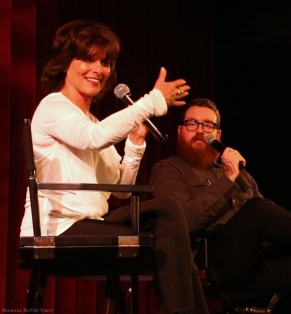 Coolidge After Midnight honors actress, singer, and author ADRIENNE BARBEAU at the Coolidge Corner Theatre. The Boston audience was treated to a 35mm film screening of THE FOG (1979), followed by a special award ceremony and Q&A with Ms. Barbeau.
Coolidge After Midnight honors actress, singer, and author ADRIENNE BARBEAU at the Coolidge Corner Theatre. The Boston audience was treated to a 35mm film screening of THE FOG (1979), followed by a special award ceremony and Q&A with Ms. Barbeau.


